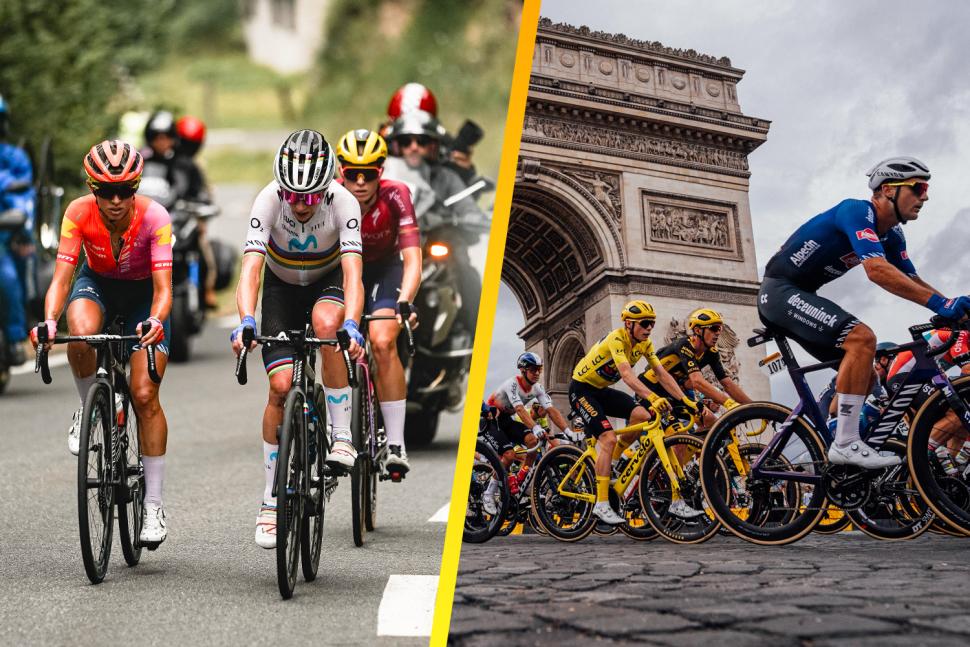Having been out in Brittany ahead of the Tour de France Femmes Grand Départ, I was lucky enough to ride along the same route as the pros on the first two stages with The Route. The Femmes might be a lot shorter than the men’s Tour de France – with nine stages making up the former as opposed to 21 for the latter – so common wisdom might lead some to believe that the Femmes is an ‘easier’ challenge for its participants. Let’s find out whether there’s any truth in this, and ask an expert what she makes of comparisons between the two events. I also have plenty of thoughts of my own…
How ‘hard’ is a Tour de France Femmes stage?
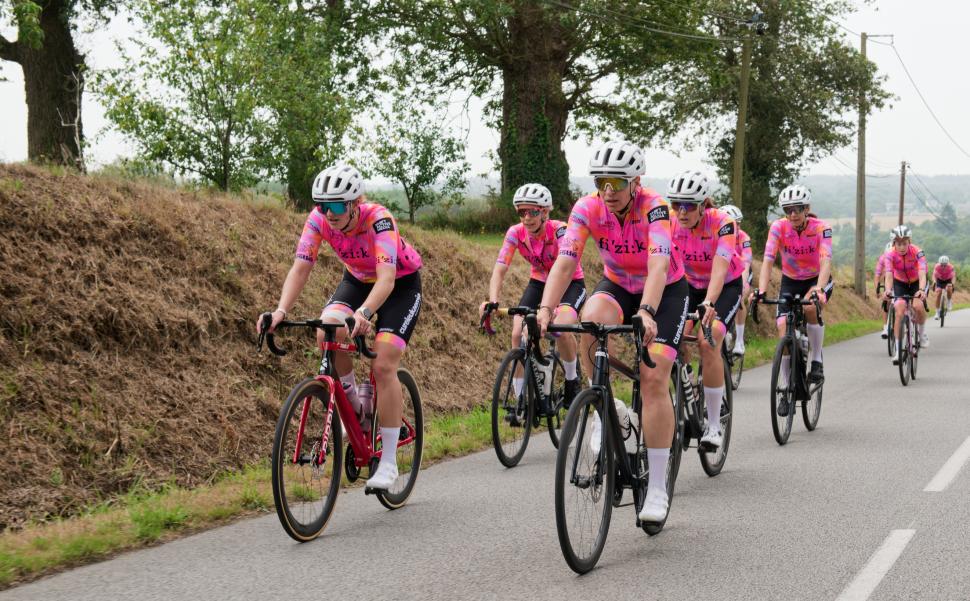 2025 Emily TdFFaZ The Route riding shot ©Joolze Dymond (credit: Joolze Dymond)
2025 Emily TdFFaZ The Route riding shot ©Joolze Dymond (credit: Joolze Dymond)
The Tour de France Femmes started in the Brittany region of France, with stage 1 being a relatively short 78.8km route covering just under 1,000m of elevation from Vannes to Plumelec, followed by a hilly 110.4km run from Brest to Quimper. Stage 1 is around 100km shorter than the shortest men’s bunch stage across three weeks –but having ridden it myself, I can tell you shorter doesn’t necessarily mean easier.
It featured four classified climbs, including the Côte de Botségalo (0.8km at 5.3%) after 29.3km, before hitting a finishing circuit with three ascents of the Côte de Cadoudal – 1.7km at 6.2% – the final climb doubling as the finish line. Brittany’s punchy ramps can sap the legs long before the finishing ascent.
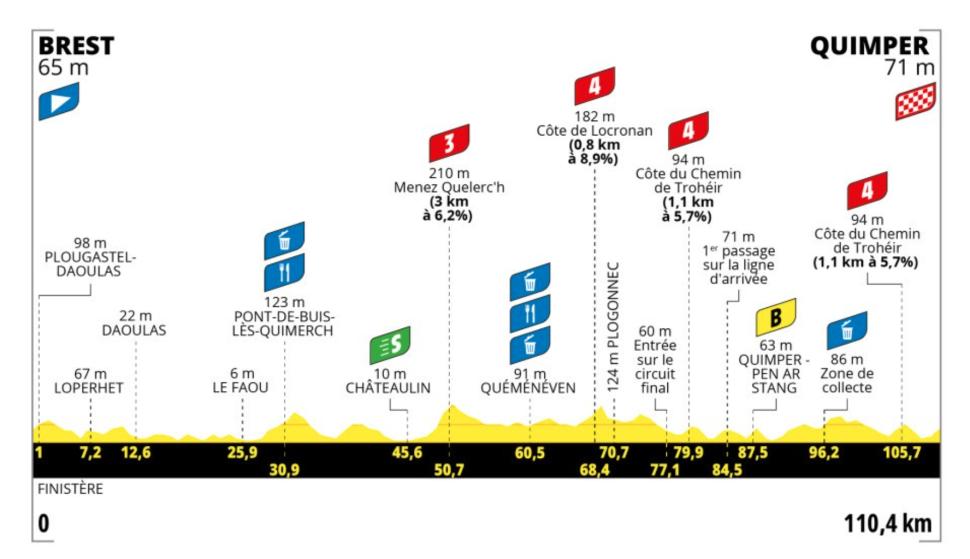 2025 Tour de France Femmes avec Zwift stage 2 profile (credit: Le Tour)
2025 Tour de France Femmes avec Zwift stage 2 profile (credit: Le Tour)
Stage 2 might have looked more forgiving, and was originally classified as flat by the organisers, but was upgraded to hilly before the start. There were four categorised climbs and an uphill finish, with the longest climb of the day being the Menez Quelerc’h after 50.7km which is 3km long at 6.2%.
Across the whole race, the women cover 1,165km – the longest edition of the Femmes so far – with a mix of two flat stages, three hilly stages, two medium mountain days and two high mountain stages. There’s no time trial this year, a deliberate choice in an attempt to keep all the drama in the mountains, and with no rest days and just nine stages in total, there’s no room to hide – every day matters.
With fewer stages, every mistake is magnified and each day has a much bigger impact on the overall. The Tour de France Femmes might be shorter, but it’s raced flat-out from start to finish.
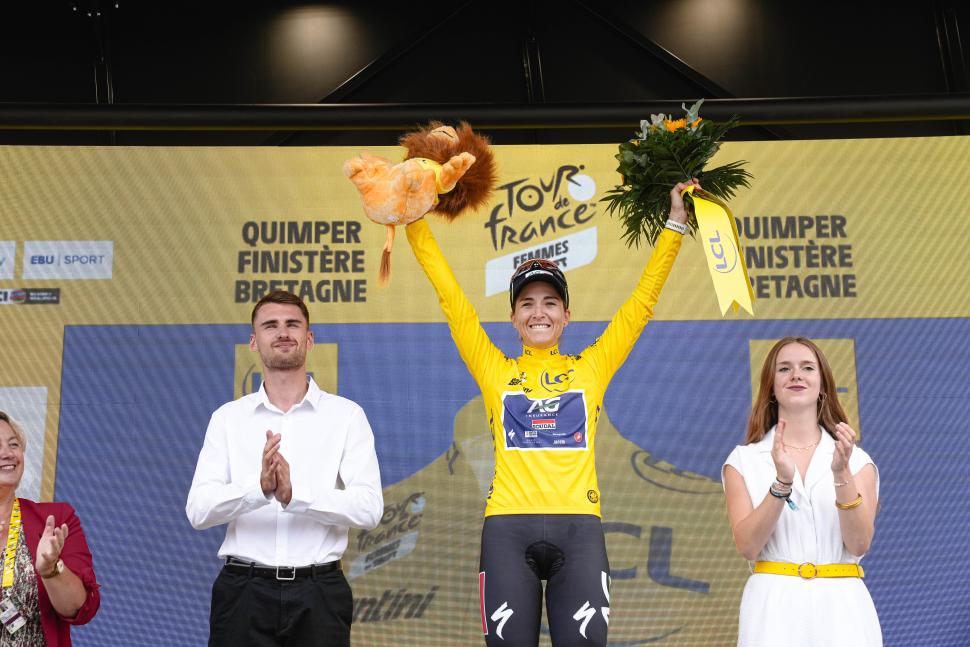 Kim Le Court in the yellow jersey, stage 2, 2025 Tour de France Femmes (credit: ASO/Thomas Maheux)
Kim Le Court in the yellow jersey, stage 2, 2025 Tour de France Femmes (credit: ASO/Thomas Maheux)
Megan Chard, Assistant Sports Director at Liv AlUla Jayco, says: “In the men’s Tour you have 21 opportunities; in the women’s, it’s nine.
“That means mistakes are magnified and there’s less room to let a stage go. In previous years we saw dominant teams take most of the wins, but this year already feels more open. We’ve had three different teams winning the first three stages, and I think it’s open this year to have more winners.”
Chard also talk about the unique intensity of women’s racing:
“Women’s cycling is different to men’s, it is not as structured. There’s not often a break of 15 riders because of the fewer opportunities, and riders don’t want to just give five stages away for free to protect GC.”
It’s also not just about the racing that makes it tough. The logistics add another layer of fatigue, with riders often having long transfers after each stage, eating into recovery time. After stage 1, they faced just over two hours, and after stage 2 it was around 90 minutes.
Why is the Tour de France Femmes still shorter than the men’s?
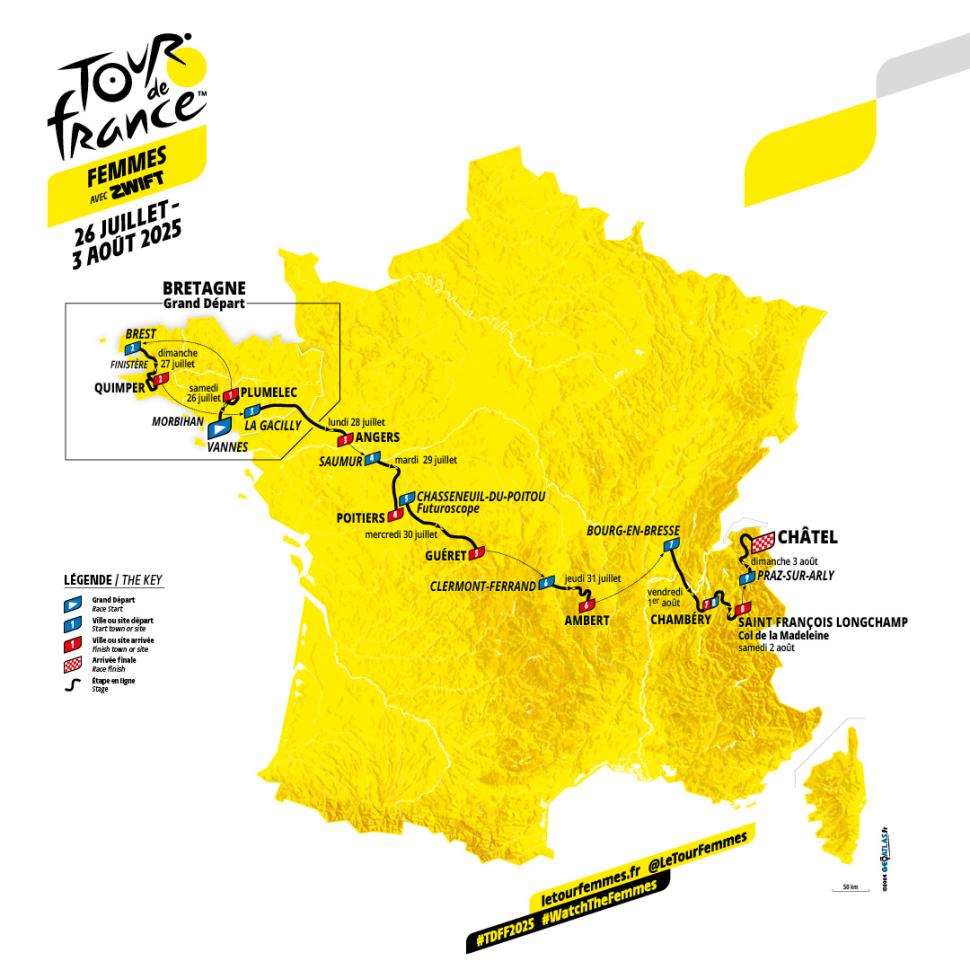 2025 Tour de France Femmes route (credit: Le Tour)
2025 Tour de France Femmes route (credit: Le Tour)
The Femmes covers around a third of the distance of the men’s Tour de France, but that’s not because anyone doubts the women’s physical ability.
The real reasons are financial and logistical. Sponsorship and broadcast deals are still catching up with the rapid growth of women’s cycling, and organisers are trying to find the ‘sweet spot’ – long enough to be a proper test, but short enough to keep audiences engaged and sponsors on board.
UCI rules have also historically limited the number of stages for women’s races, with a maximum of six set for most elite events. The Tour de France Femmes, like the Giro d’Italia Women and the Vuelta España Femenina, has an exemption, but those restrictions were originally introduced to avoid overcrowding the calendar, and to give women’s racing space to grow.
The good news? It is growing. Last year’s edition was eight days, this year it’s nine, and there’s hope it will expand further in the future.
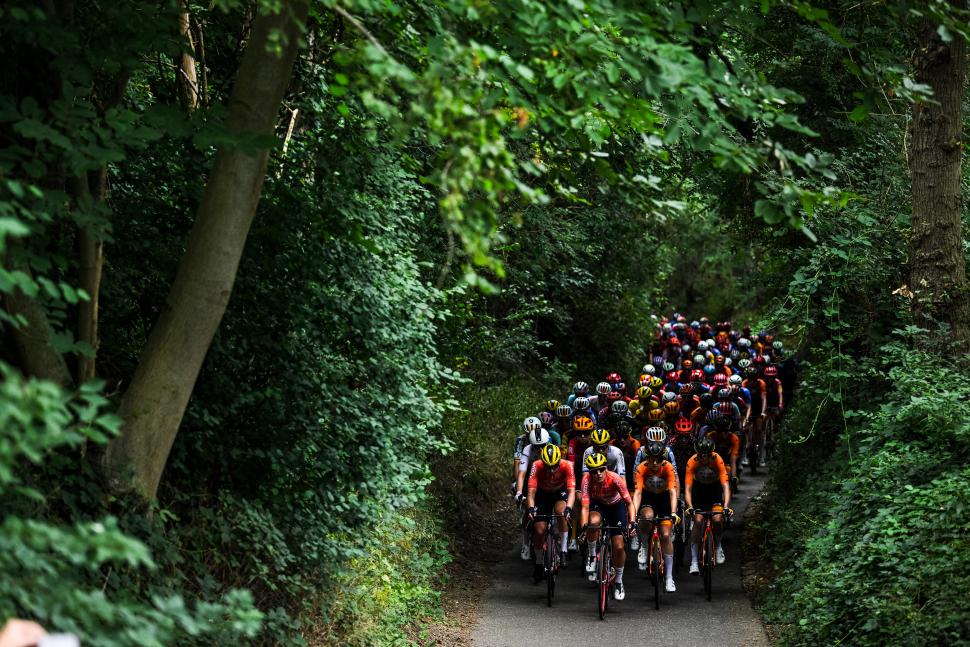 2024 Tour de France Femmes, stage four (A.S.O./Charly Lopez) (credit: A.S.O./Charly Lopez)
2024 Tour de France Femmes, stage four (A.S.O./Charly Lopez) (credit: A.S.O./Charly Lopez)
Chard believes that while a longer Tour de France Femmes would be a great step forward, it needs to be introduced at the right time:
“It would be great to have a three-week Tour, but the logistics behind it aren’t simple.
“For example, it’s less than a month between the Giro and the Tour, and then Romandie straight after. Is there enough time to put a three-week tour into the calendar when we don’t have the same number of riders in teams as the men?
“Teams would need more resources – vehicles, staff, and that means increased budgets. Women’s cycling has changed so much in recent years, and we need to make sure the races we have now are sustainable before we push for more.”
While many want to see the Femmes increase in length in the future, the shorter format does have one big advantage: it’s really exciting to watch in my opinion. There are no long transition stages, every mistake counts, and the aggressive, attacking racing means the general classification can change in seconds.
How far we have (or haven’t) come…
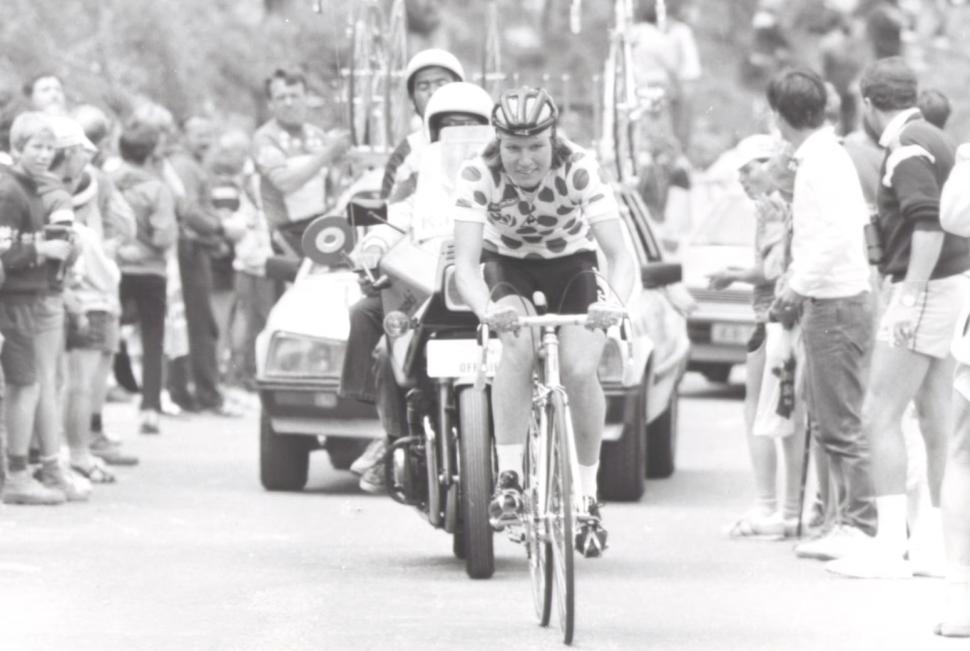 Marianne Martin, 1984 Tour de France (Marianne Martin) (credit: road.cc)
Marianne Martin, 1984 Tour de France (Marianne Martin) (credit: road.cc)
Back in 1984, the first Tour de France Féminin ran alongside the men’s race, featuring 18 stages and covering a total distance of 1,066km — less than what the women now complete in just nine days at the Tour de France Femmes. It was won by Marianne Martin and is often called “the perfect Tour de France”, since it was a landmark moment with women riding a shortened version of the men’s route just a couple of hours ahead of them.
From 1992 to 2009, the Grand Boucle Féminine Internationale carried the torch for women’s stage racing in France, but over time it gradually declined due to financial struggles, organisational issues, and limited media exposure.
It wasn’t until 2022 that ASO revived the Tour de France Femmes, bringing a growing global audience. Since that inaugural modern edition, the race has improved year on year, increasing in length, delivering aggressive racing, and attracting record audiences.
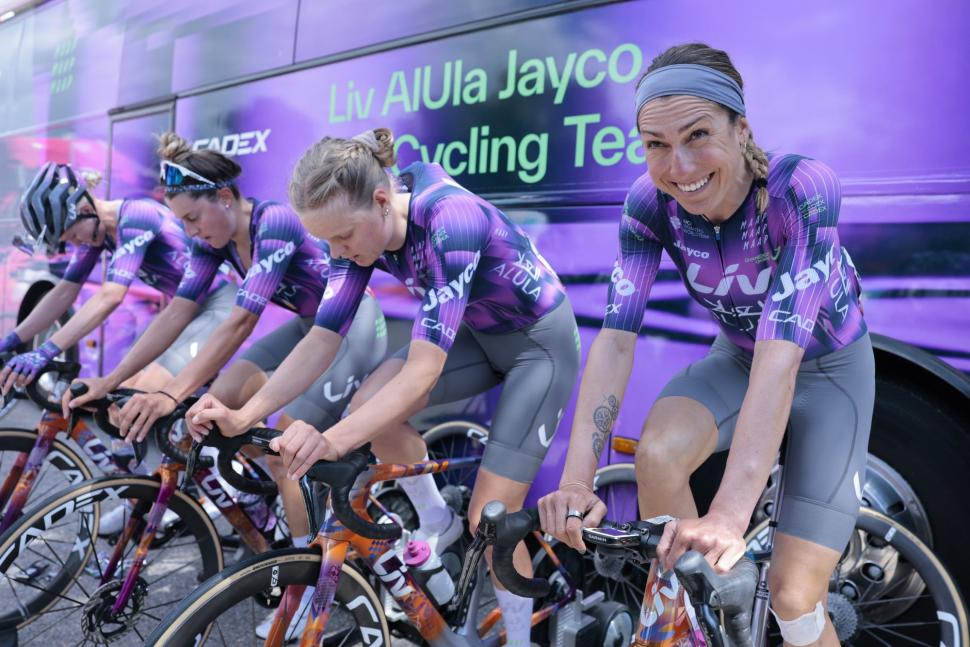 2025 Liv AlUla Jayco warm up (credit: GreenEdge Cycling)
2025 Liv AlUla Jayco warm up (credit: GreenEdge Cycling)
The way women’s cycling is growing now is truly exciting. When you compare today’s Tour de France Femmes to the 1984 edition, the difference is incredible. Many riders today are full-time professionals with salaries, supported by teams, buses, and staff. It’s very different, and a much stronger position for the sport to be in.
Chard says: “It’s important to pause and appreciate how far we’ve come, remembering those original riders who fought for these opportunities. The growth over the past 5–10 years has been phenomenal; riders have transitioned from juggling other jobs to full-time cycling careers.”
What I’d like to see next
The Tour de France Femmes isn’t a ‘lite’ version of the men’s race – it’s already one of the most exciting events on the calendar.
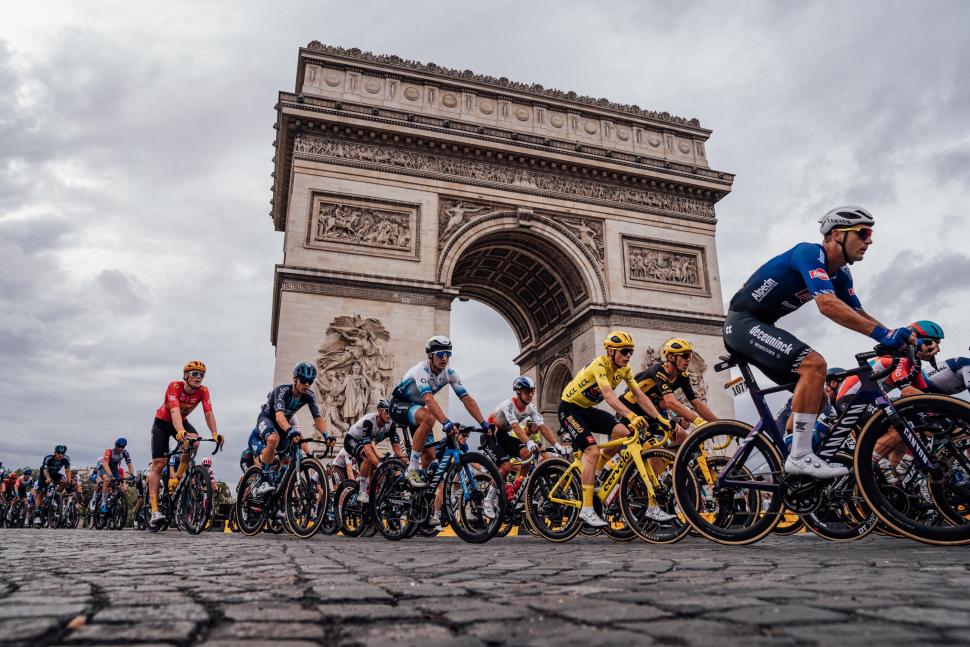 2023 Tour de France – Stage 21 Saint-Quentin-en-Yvelines to Paris © Zac WiLLIAMS SWpix.com (t:a Photography Hub Ltd (credit: Simon Wilkinson/SWpix.com)
2023 Tour de France – Stage 21 Saint-Quentin-en-Yvelines to Paris © Zac WiLLIAMS SWpix.com (t:a Photography Hub Ltd (credit: Simon Wilkinson/SWpix.com)
What I’d love to see going forward isn’t necessarily a much longer race, but more of the iconic Tour de France feel – the climbs and the big finish-line moments. For example, the first stage of the modern edition in 2022 took place on the Champs-Élysées, the same day as the men’s final stage. Paris is the Tour’s trademark finish, and it feels right for the women to have that too.
Adding more iconic climbs and perhaps a decisive uphill time trial would deepen the race’s complexity, all without needing to mirror the men’s format stage-for-stage.
What really matters most is ensuring the race is sustainable, pushing for more equal prize money, and continuing to improve coverage. In my opinion, these will do far more for the sport than simply extending the race to 21 days before the teams and infrastructure are fully ready.
So, is the Femmes ‘easier’?
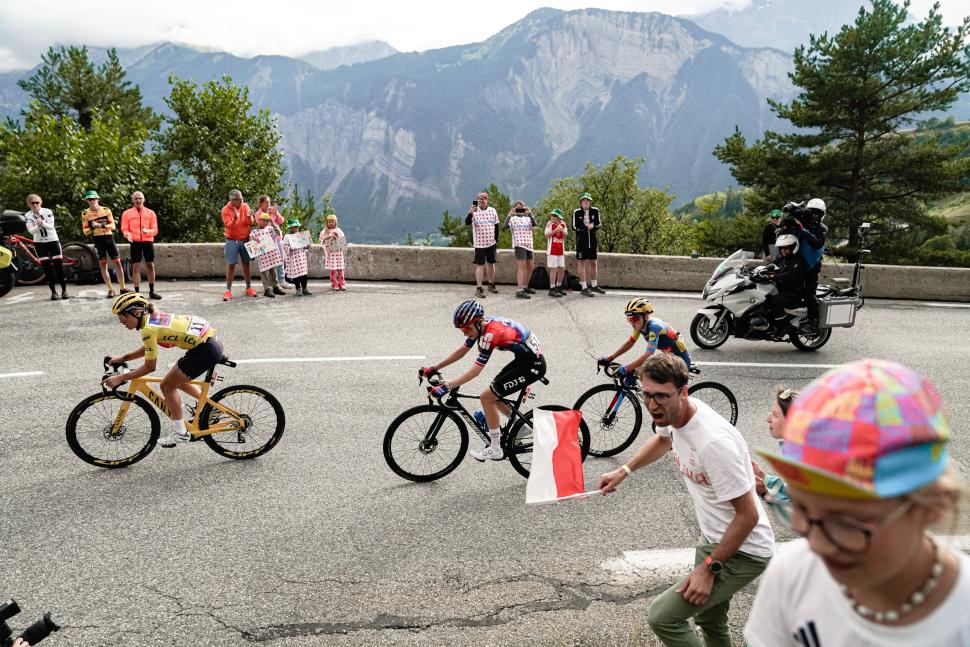 Kasia Niewiadoma, stage eight, Alpe d’Huez, 2024 Tour de France Femmes (A.S.O./Thomas Maheux) (credit: road.cc)
Kasia Niewiadoma, stage eight, Alpe d’Huez, 2024 Tour de France Femmes (A.S.O./Thomas Maheux) (credit: road.cc)
It’s not really a question of easier or harder — it’s a different challenge. The women’s race is shorter in distance and duration, but that doesn’t mean it’s any less intense. With fewer stages and no rest days, every single day is raced flat-out, which makes it incredibly demanding and unforgiving.
So while the men cover more kilometres/miles over three weeks, the Femmes packs in a huge amount of intensity, tactical complexity, and drama into a shorter time frame.
Chard agrees that direct comparisons to the men’s race aren’t always useful:
“Should we even be comparing the two in the first place?
“Women’s cycling is different. The men’s calendar isn’t necessarily the perfect model or the end goal, and we should be working with what we have and improving that.”
Is the Tour de France Femmes ready to go longer, or is the current format just right? Let us know your thoughts in the comments section below.
